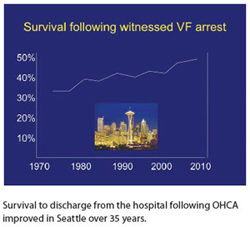Seattle Medic Two CPR Training
In Seattle, Washington, the 2011 survival rates for EMS-treated witnessed VF have reached 52%, according to Tom Rea, MD, Medical Director of King County Medic One. For decades, the activities of the EMS programs in Seattle and surrounding King County have served as the role models for communities and EMS systems who work to improve their SCA survival rates.
 Their commitment to excellence has driven a multitude of quality improvement initiatives designed to evaluate the system. To reach a 52% survival rate among witnessed VF SCA victims, Seattle Fire Department, Seattle Fire Department, a fire department-based EMS system, has been measuring all aspects of their community’s response to out-of-hospital cardiac arrest (OHCA) since the early 1970s.10 Using the measurements to identify opportunities, the system has made continual improvements in survival over more than three decades.
Their commitment to excellence has driven a multitude of quality improvement initiatives designed to evaluate the system. To reach a 52% survival rate among witnessed VF SCA victims, Seattle Fire Department, Seattle Fire Department, a fire department-based EMS system, has been measuring all aspects of their community’s response to out-of-hospital cardiac arrest (OHCA) since the early 1970s.10 Using the measurements to identify opportunities, the system has made continual improvements in survival over more than three decades.
In 1971, to improve a victim’s chances of receiving bystander CPR, Dr. Leonard Cobb organized Medic II, the public training arm of the Seattle Fire Department. Over the next two years, the program trained more than 100,000 citizens in CPR. The Medic II Programtaught CPR to more than 771,000 people through 2009, and it continues to provide CPR training for about 13,000 Seattle/King County residents each year. Over time, more than half of the 1.3 million residents of the Seattle and surrounding King County area have received CPR training. During 2008, bysta nders initiated CPR for 58% of victims who were in cardiac arrest when EMS arrived, a figure considerably higher than most other communities.11
911 Dispatchers Are Critical
All communities should provide CPR instructions over the telephone when someone calls 911 to request assistance for a sudden cardiac arrest. Dispatchers who assertively provide CPR instructions to the caller at the time of the emergency significantly increase CPR rates, and that saves lives. Providing dispatcher-assisted CPR instructions requires meticulous training of the defined group of 911 dispatchers and call takers, but they are an accessible group to train. Since the number of 911 call takers is a small fraction of the community’s population, this strategy provides a very effective approach for increasing the rate of bystander CPR. The EMS Medical Director can tell you more about your community’s plan to increase bystander CPR using telephone CPR instructions.
The Seattle and King County Experience
Dispatcher-assisted CPR instructions were first implemented in Seattle in 1981. The original goal was to provide CPR instructions over the telephone to bystanders while waiting for EMS help to arrive. In recent years, the instructions have evolved to consist of a very quick assessment of whether CPR is required followed by especially assertive instructions to motivate the caller to start CPR as quickly as humanly possible.
The program is successful. In 2010 in Seattle and surrounding King County, the overall rate of bystander CPR is above 50%. Among all victims who receive bystander CPR in these communities, 60% is provided by citizens who know CPR, and 40% is provided by citizens who are directed by the 911 dispatchers. The Seattle and King County programs includes comprehensive quality improvement activities, with targeted training for the dispatchers and routine review of all 911 calls possibly related to OHCA. The time it takes to get CPR started as well as other benchmarks are routinely shared with the dispatchers to improve their performance.

